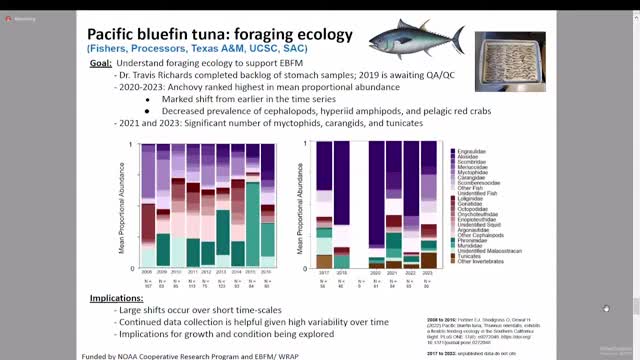Research reveals dramatic shifts in bluefin tuna diets
September 23, 2024 | Fishery Management Council, Pacific, Governor's Office - Boards & Commissions, Executive, Washington
This article was created by AI summarizing key points discussed. AI makes mistakes, so for full details and context, please refer to the video of the full meeting. Please report any errors so we can fix them. Report an error »

In a recent government meeting, significant discussions centered around the dietary patterns of bluefin tuna and swordfish, revealing notable shifts in their prey preferences over the years. Dr. Yao presented findings from a comprehensive study that analyzed bluefin tuna diets from 2008 to 2023, highlighting a marked increase in anchovy consumption, which has now become the most prevalent prey. This change contrasts with earlier data, where cephalopods and pelagic red crabs were more dominant in their diets.
The research indicates that the bluefin tuna population is adapting to changes in prey availability, suggesting a dynamic ecosystem. Dr. Yao emphasized the importance of ongoing data collection to further understand these dietary shifts and their implications for the species' health and sustainability.
Swordfish foraging ecology was also discussed, with data spanning from 2007 to 2023 showing fluctuations in prey types, particularly a transition from cephalopods to fish, including the emergence of anchovies in their diets since 2016. This research was published in 2023, underscoring the continuous efforts to monitor and understand these species.
Dr. Lendt expressed optimism regarding the health of bluefin tuna stocks, noting that they have been successfully rebuilt ahead of schedule, a significant achievement in fisheries management. The collaborative efforts with stakeholders, including commercial and recreational fishers, were highlighted as crucial for gathering additional data and enhancing research outcomes.
Questions from attendees focused on the complexities of stock assessments, particularly regarding the uncertainty in estimates of overfishing. Dr. Yao clarified that the visual representations used in assessments, including egg-shaped probability distributions, illustrate the uncertainty surrounding stock status, a common practice in scientific evaluations.
The meeting concluded with a request for updates on the National Environmental Policy Act (NEPA) work related to the SNAP GEAR project, with assurances that necessary documents are in the clearance process, albeit with no definitive timeline due to the complexity and potential for litigation.
Overall, the discussions reflected a commitment to ongoing research and collaboration aimed at ensuring the sustainability of vital fish stocks in the Pacific.
The research indicates that the bluefin tuna population is adapting to changes in prey availability, suggesting a dynamic ecosystem. Dr. Yao emphasized the importance of ongoing data collection to further understand these dietary shifts and their implications for the species' health and sustainability.
Swordfish foraging ecology was also discussed, with data spanning from 2007 to 2023 showing fluctuations in prey types, particularly a transition from cephalopods to fish, including the emergence of anchovies in their diets since 2016. This research was published in 2023, underscoring the continuous efforts to monitor and understand these species.
Dr. Lendt expressed optimism regarding the health of bluefin tuna stocks, noting that they have been successfully rebuilt ahead of schedule, a significant achievement in fisheries management. The collaborative efforts with stakeholders, including commercial and recreational fishers, were highlighted as crucial for gathering additional data and enhancing research outcomes.
Questions from attendees focused on the complexities of stock assessments, particularly regarding the uncertainty in estimates of overfishing. Dr. Yao clarified that the visual representations used in assessments, including egg-shaped probability distributions, illustrate the uncertainty surrounding stock status, a common practice in scientific evaluations.
The meeting concluded with a request for updates on the National Environmental Policy Act (NEPA) work related to the SNAP GEAR project, with assurances that necessary documents are in the clearance process, albeit with no definitive timeline due to the complexity and potential for litigation.
Overall, the discussions reflected a commitment to ongoing research and collaboration aimed at ensuring the sustainability of vital fish stocks in the Pacific.
View full meeting
This article is based on a recent meeting—watch the full video and explore the complete transcript for deeper insights into the discussion.
View full meeting
